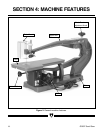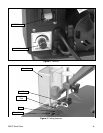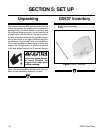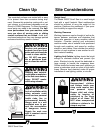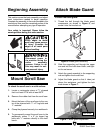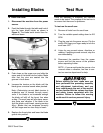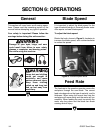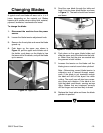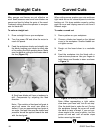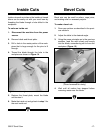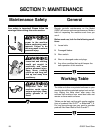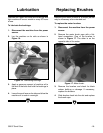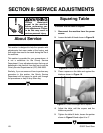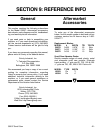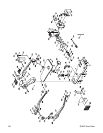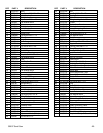
-16-
G0537 Scroll Saw
Miter gauges and fences are not effective on
scroll saws because most scroll saw blades are
narrow and tend to follow the grain of the wood.
Freehand cutting allows the operator to compen-
sate for blade drift.
To make a straight cut:
1. Draw a straight line on your workpiece.
2. Turn the power ON and allow the motor to
reach full speed.
3. Feed the workpiece slowly and steadily into
the blade, keeping your hands to either side
of the cutting line while pushing down. Make
sure the blade is cutting on the waste side of
the line (Figure 12).
Figure 12. Straight cut.
When cutting curves, preplan your cuts and leave
tight inside curves for a second pass to minimize
backing out. Cut sharp outside curves by cutting
past the curve and looping around to cut from a
different angle.
To make a curved cut:
1. Draw a pattern on your workpiece.
2. Choose a blade size based on the tightest
curve in the workpiece. Smaller blades can
cut tighter curves.
3. Rough cut the board down to a workable
size.
4. Feed the workpiece into the blade with a
slow and even pressure. Use your fingers to
hold it down and thumbs to steer as shown
in Figure 13.
Figure 13. Making a curved cut.
4. Scroll saw blades will have a tendency to
drift. Compensate by adjusting the feed
direction.
Note—The variation of hard and soft grain in
wood will cause the scroll saw blade to
deflect. If you are approaching hard grain at
an angle, the feed rate must be slowed and
pressure should be applied toward the side
with the hard grain.
Note—When approaching a tight radius,
slow down your feed rate, but do not stop.
Give the teeth time to make the cut. Forcing
the workpiece through the curve will cause
the blade to twist or break. If your cut pro-
duces waste in the curve’s interior, turn the
power off and wait until all motion stops
before removing the waste.
Curved CutsStraight Cuts



